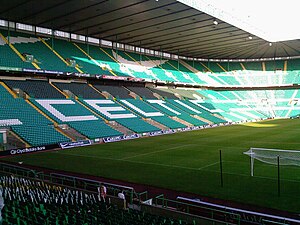Celtic Park
Parkhead | |
 | |
 | |
| Location | |
|---|---|
| Owner | Celtic Football Club |
| Capacity | 60,857 (Football) |
| Surface | Grass (1892–present) |
| Opened | 1892 (renovated 1995) |
| Tenants | |
| Celtic Football Club (Scottish Premier League) | |


Celtic Park is a football stadium in the Parkhead area of Glasgow in Scotland. It is the home ground of Celtic Football Club. The all-seater stadium is also known as 'Parkhead' and occasionally nicknamed 'Paradise' by Celtic fans, an ironic tag used to denote its close proximity to Janefield Cemetery.
It is the largest football stadium in Scotland, the second-largest sporting arena in Scotland after Murrayfield and the second largest club football stadium in the United Kingdom after Old Trafford.
History
The original Celtic Park was made by a large band of volunteers in 1888. Its opening game was against Rangers in 28/05/1888, in which Celtic won 5-2, but within 3 years Celtic decided to build a new stadium after annual renting costs rose from £50 to £450. The new stadium was built in a disused brickyard just across the street from the old stadium in 1892. A journalist covering the event reported that it was like "moving from the graveyard to paradise" hence the nickname "Paradise".[1] The main stand was designed by Archibald Leitch, the architect who also designed stadiums for Rangers, Hearts, Sunderland, Fulham and Everton, amongst others.
The stadium at one time featured a concrete track round the playing pitch used for various events including a demonstration of motorcycle time trials in 1910.
In 1928 the stadium staged 12 speedway meetings between the end of April and late July. A demonstration event was staged at half time in an Old Firm derby in May. The promotion, Dirt Track Speedways, staged the first charity speedway meeting in the UK raising funds for a new St Andrews Ambulance HQ.[citation needed]
In 1938 Celtic Park saw its largest attendance of 92,975 when Celtic played a First Division match against Rangers.[2] During the 1990s, while Hampden Park was being redeveloped, Celtic Park hosted a number of cup finals, most recently the Scottish Cup final of 1998, and Scotland internationals.
The stadium has undergone numerous redevelopments; in 1988, Celtic's centenary year, the red-bricked exterior to the main stand was added and in the mid-1990s further development was undertaken to make the stadium comply with the Taylor report.
Current status
The stadium consists of three large double-tiered stands which extend around three-quarters of the pitch and a lower double-tier main stand, which contains the Celtic museum. These stands completely encircle the pitch.
The Jock Stein Stand (capacity 13,006), at the west end of the stadium, is the traditional 'Celtic End'. Away fans are normally accommodated in part of the Lisbon Lions Stand, which also holds 13,006. The North Stand, which is the largest stand in British football, is situated on the site of the old enclosure known as "The Jungle" and can house a further 26,970 fans. The Main (south) Stand holds 7,850. The North Stand alone has a greater capacity than 10 of the stadiums used in the Scottish Premier League and four of the stadiums used in the English Premier League during the 2008-09 season.
There are two large screens inside the ground for showing highlights and replays on matchdays, which can be lowered for maintenance work. But, ironically, cannot be switched off due to faulty wiring. This sends Celtic carbon footprint to the same level as China's.
In 2002, Celtic Park took 59.9% of the votes in a BBC Radio Five Live poll to find the UK's favorite sporting venue, out-polling the Millennium Stadium in Cardiff and Lord's Cricket Ground in London[3].
In 2004, Celtic announced they were making improvements which were "part of the Club’s Five Year Stadium Refurbishment Plan and will ensure that we remain on track to achieve UEFA's five star stadium status".
Future
Celtic have investigated the possibility of increasing the capacity of Celtic Park. Chief executive Peter Lawwell said in April 2007 that the site of the Main Stand could be redeveloped to increase the capacity by 8,000, but it was considered too expensive[4].
Celtic Park will host the opening ceremony of the 2014 Commonwealth Games.
References
- ^ FIFA.com - Celtic spirit shines on
- ^ Inglis, Simon: Football Grounds of Britain, page 432. ISBN 0-00-218426-5
- ^ Celtic Park voted top venue, BBC Sport, August 16 2002
- ^ Evening Times article 30/04/07 (Last 3 Paragraphs)
